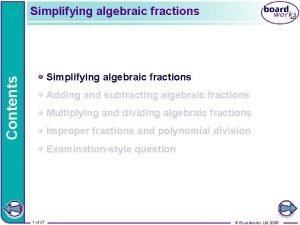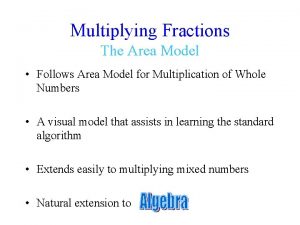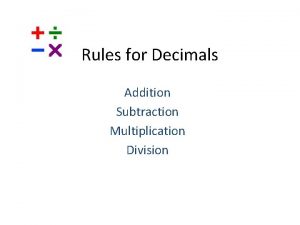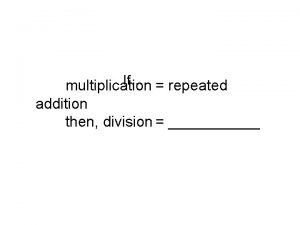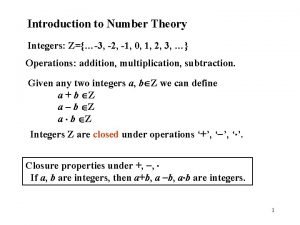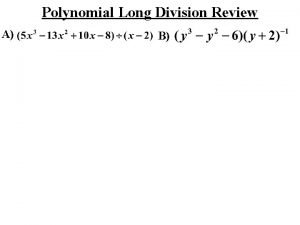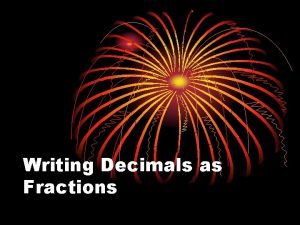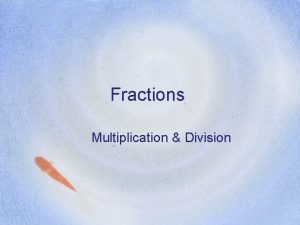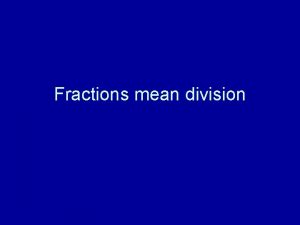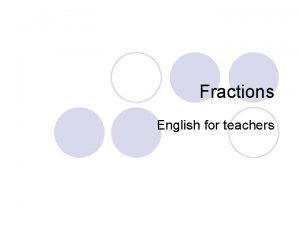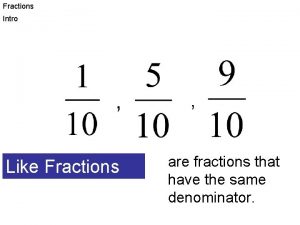6 3 Multiplication Division of Fractions Review Multiplication








































- Slides: 40

§ 6. 3 Multiplication & Division of Fractions Review: Multiplication of whole numbers means repeated addition. This is also true for multiplying a whole number to a fraction. e. g. 1 1 3 3 = + + = 5 5 5 This shows that in general, we should have a k = b b

Multiplication of Fractions When we multiply a fraction to a fraction, the meaning is rather different because we cannot use repeated addition. Definition: means of We are going to see several examples that can help you understand more.

Example 1 Jordan got 1 3 of a chocolate bar from his sister. He ate ½ of it during lunch break and saved the rest for the evening. How much of a chocolate bar did he eat during lunch break? Let us answer this question by drawing diagrams. (click) the whole piece of chocolate 3 of 1 the whole ½ of 1 3 From the last diagram, we see that the yellow piece he ate is equal to 1 out of 6 from the whole bar. Therefore ½ of 1 3 is 1 6.

Example 1 Jordan got 1 3 of a chocolate bar from his sister. He ate ½ of it during lunch break and saved the rest for the evening. How much of a chocolate bar did he eat during lunch break? Let us answer this question by drawing diagrams. (click) the whole piece of chocolate 3 of 1 the whole ½ of 1 3 From the last diagram, we see that the yellow piece he ate is equal to 1 out of 6 from the whole bar. Therefore ½ of 1 3 is 1 6.

Example 1 Jordan got 1 3 of a chocolate bar from his sister. He ate ½ of it during lunch break and saved the rest for the evening. How much of a chocolate bar did he eat during lunch break? Let us answer this question by drawing diagrams. (click) the whole piece of chocolate 3 of 1 the whole ½ of 1 3 From the last diagram, we see that the yellow piece he ate is equal to 1 out of 6 from the whole bar. Therefore ½ of 1 3 is 1 6.

Example 1 Jordan got 1 3 of a chocolate bar from his sister. He ate ½ of it during lunch break and saved the rest for the evening. How much of a chocolate bar did he eat during lunch break? Let us answer this question by drawing diagrams. (click) the whole piece of chocolate 3 of 1 the whole ½ of 1 3 From the last diagram, we see that the yellow piece he ate is equal to 1 out of 6 from the whole bar. Therefore ½ of 1 3 is 1 6.

Jordan got 1 3 of a chocolate bar from his sister. He ate ½ of it during lunch break and saved the rest for the evening. How much of a chocolate bar did he eat during lunch break? Let us answer this question by drawing diagrams. (click) the whole piece of chocolate 3 of 1 the whole ½ of 1 3 From the last diagram, we see that the yellow piece he ate is equal to 1 out of 6 from the whole bar. Therefore ½ of 1 3 is 1 6.

Jordan got 3 of a chocolate bar from his sister. He ate ½ of it during lunch break and saved the rest for the evening. How much of a chocolate bar did he eat during lunch break? Let us answer this question by drawing diagrams. (click) the whole piece of chocolate 3 of 1 the whole ½ of 1 3 From the last diagram, we see that the yellow piece he ate is equal to 1 out of 6 from the whole bar. Therefore ½ of 1 3 is 1 6.

during lunch break and saved the rest for the evening. How much of a chocolate bar did he eat during lunch break? Let us answer this question by drawing diagrams. (click) the whole piece of chocolate 3 of 1 the whole ½ of 1 3 From the last diagram, we see that the yellow piece he ate is equal to 1 out of 6 from the whole bar. Therefore ½ of 1 3 is 1 6.

a chocolate bar did he eat during lunch break? Let us answer this question by drawing diagrams. (click) the whole piece of chocolate 3 of 1 the whole ½ of 1 3 From the last diagram, we see that the yellow piece he ate is equal to 1 out of 6 from the whole bar. Therefore ½ of 1 3 is 1 6.

Let us answer this question by drawing diagrams. the whole piece of chocolate 3 of 1 the whole ½ of 1 3 From the last diagram, we see that the yellow piece he ate is equal to 1 out of 6 from the whole bar. Therefore ½ of 1 3 is 1 6. 1 1 According to our definition, ½ of 1 3 is . 2 3 Hence 1 1 = 1 2 3 6

Multiplication of Fractions Examples 2 On the other day, Jordan got 5 8 of a chocolate bar from his mom and he gave 2 3 of that to his younger brother. How much of the original bar did he give away? (click) whole piece of chocolate 8 of the 5 whole 3 of 5 8 2

Multiplication of Fractions In the diagram we see that the whole is cut into 3 columns and 8 rows, hence there should be 3 × 8 = 24 equal pieces in the whole. 3 of 5 8 2 The yellow portion has 2 columns and 5 rows, hence it has 2 × 5 = 10 such pieces. This shows that the yellow portions takes up 10 24 of the whole. i. e. 2 5 2 5 10 = = 3 8 3 8 24

Multiplication of Fractions Conclusion: Exercises: 1. Calculate 3 2 = 6 = 3 4 5 10 4 5 20 (after dividing top and bottom by 2) 2. Calculate 4 5 20 = = 7 9 63 3. Calculate 5 6 5 2 10 5 5 6 6 = = = = 9 1 3 1 3 9

Division of Fractions Review: there are two approaches of division 1. Repeated subtraction: If there are 12 cookies and we want to take away 3 cookies at a time, how many times can we do this until there is none left? 2. Sharing approach: If there are 12 cookies, and we want to separate them into 3 equal groups, how many cookies will be in each group? When we are dividing by whole numbers, both approaches work fine, but when we are dividing by fractions, the repeated subtraction approach will be more appropriate.

Why should 3 ÷ 8 be 8 ? 3 Before we know the existence of fractions, the problem 3 ÷ 8 cannot be solved, and there will be a remainder of 3. Now we can use fractions, what would be the appropriate answer to 3 ÷ 8 ? Let’s consider the following example: There are 3 cakes to be divided evenly among 8 people, how can this be done fairly and how much of a cake will each person get?

Solution: The most logical way to do this is to cut each cake in to 8 equal pieces, and then 1 by 1 give out the pieces until every children has the same number of pieces. (click to see animation)

Solution: The most logical way to do this is to cut each cake in to 8 equal pieces, and then 1 by 1 give out the pieces until every children has the same number of pieces.

Solution: The most logical way to do this is to cut each cake in to 8 equal pieces, and then 1 by 1 give out the pieces until every children has the same number of pieces. In the end, each person will have 3 equal pieces, and since each piece is 1/8, the total amount each person will get is 3/8. Therefore the answer to 3 ÷ 8 should be 3/8.

Conclusion: For any non-zero whole numbers a and b, a ÷ b = a b. Exercises 1. What is 3 ÷ 4? 3 answer : 4 2. What is 6 ÷ 5? 6 answer : 5 3. What is 12 ÷ 9? 12 4 answer : = 9 3

Division of Fractions – the Graphical Representation of Repeated Subtraction Example 1: Perform (1) (2) (3) (4) Start with 5 wholes. Divide each whole into halves (i. e. find a common denominator. ) Color 1/2 each time with different colors. Count how many color used.

Division of Fractions – the Graphical Representation of Repeated Subtraction (1) (2) (3) (4) Start with 4 wholes. Divide each whole into thirds (i. e. find a common denominator. ) Color 2/3 each time with different colors. Count how many color used.

More on division by whole numbers 5 ÷ 3 = ? 5 3 c unit How many copies of the lime green rod is in the yellow rod? c c c The answer is 1 + 2/3, which equals to 5/3. Hence 5 ÷ 3 is equal to 5/3.

More on division by whole numbers 9 ÷ 4 = ? c 9 4 unit How many copies of the magenta rod is in the blue rod? c c The answer is 2 + 1/4, which equals to 9/4. Hence 9 ÷ 4 is equal to 9/4.

Division of Fractions with a common denominator What is equal to? Solution: ¼¼¼¼¼¼¼¼ ÷ ¼¼¼ one group We can see that there are 5 groups of ¾ in because 15 ÷ 3 = 5 This shows that when we divide fractions with the same denominator, we simply divide the numerators. Alternatively, we can say that

Another Example What is ? Solution: We use the fraction tiles again This represents 9/8 because it has 9 copies of 1/8 This represents 3/8 because it has 3 copies of 1/8 Now our question becomes “how many copies of are in ? ” (click to see animation) The answer is 3 because

Another Example What is ? Solution: ÷ Answer:

Division of Fractions with same Denominator unit 5/8 3/8 We picked brown as the unit because it represents 8. How many copies of the lime green rod is in the yellow rod? c c c

Division of Fractions Conclusion: When we divide fractions with equal denominators, the denominators will be cancelled out and thus we can ignore the denominator and divide just the numerators, i. e.

Division of Fractions Exercises: 10 5 ¸ ? 12 12 10 Ans : = 2 5 2. What is 16 7 ¸ ? 24 24 16 2 Ans : = 2 7 7 3. What is 13 4 ¸ ? 15 15 13 1 Ans : = 3 4 4 1. What is

Division of Fractions with different denominators Example: How can we perform the division Answer: Find a common denominator first!

Division of Fractions with different Denominators We first find the lowest common denominator, which is 6. So we use the dark green rod as our unit (b/c it’s length is 6 white cubes). Unit = c c c is represented by an orange rod b/c its length is 10 white cubes. is represented by a lime green rod b/c its length is 3 white cubes.

Division of Fractions with different Denominators How many copies of the lime green rod is in the orange rod? c c c This answer can be confirmed by algebra The 10 comes from 5× 2

Division of Fractions with different Denominators We first find the lowest common denominator, which is 10. So we use the orange rod as our unit (b/c its length is 10 white cubes) Unit = c c c c c is represented by an orange and a yellow rod is represented by a brown rod

Division of Fractions with different Denominators How many copies of the brown rod is in the orange + yellow rods? c c c c

Example: How can we perform the division 3 1 ¸ ? 4 5 The common denominator in this case is clearly 4 × 5 = 20. i. e. 3 = 3 5 = 15 4 4 5 20 Therefore and 1 1 4 4 = = 5 5 4 20 15 3 1 15 4 = 15 ¸ 4 = ¸ 4 4 5 20 20

Another example: How can we perform the division 7 2 ¸ ? 10 9 The common denominator in this case is clearly 10 × 9 = 90. i. e. 7 7 9 63 = = 10 10 9 90 Therefore 2 2 10 20 and = = 9 9 10 90 7 2 63 20 ¸ = ¸ 10 9 90 90 63 = 63 ¸ 20 = 20

Why do we multiply the reciprocal when dividing? Let us look at this example 5 2 ¸ 9 7 The common denominator in this case is clearly 9 × 7. i. e. 5 5 7 = 9 9 7 Therefore 2 2 9 = 7 7 9 and 5 2 5 7 2 9 ¸ = ¸ 9 7 7 9 5 7 = ( 5 7 ) ¸ (2 9 ) = 2 9 5 7 = = 9 2

The general (abstract) case How can we perform the division a c ¸ ? b d The common denominator in this case is clearly b × d. i. e. a a d = b b d Therefore c c b = d d b and a c a d c b ¸ = ¸ b d d b a d = ( a d ) ¸ (c b ) = c b a d = = b c

Conclusion When we divide fractions, we can multiply the dividend by the reciprocal of the divisor. a d a c ¸ = b d b c
 Simplifying complex fractions
Simplifying complex fractions Fish method fractions
Fish method fractions Area model for multiplying fractions
Area model for multiplying fractions Whole number divided by fraction word problems
Whole number divided by fraction word problems Adding and subtracting fractions review
Adding and subtracting fractions review Adding and subtracting fractions review
Adding and subtracting fractions review Maths addition subtraction multiplication division
Maths addition subtraction multiplication division What is the rule for adding decimals
What is the rule for adding decimals Solving one-step equations multiplication and division
Solving one-step equations multiplication and division Multiplication and division properties
Multiplication and division properties Multiplication and division jeopardy
Multiplication and division jeopardy 13773x
13773x How is division related to subtraction
How is division related to subtraction Division equation
Division equation Year 4 multiplication and division
Year 4 multiplication and division Error propagation for multiplication
Error propagation for multiplication Multiplying and dividing scientific notation worksheet doc
Multiplying and dividing scientific notation worksheet doc Arithmetic addition subtraction multiplication division
Arithmetic addition subtraction multiplication division Multiplication facts and division facts
Multiplication facts and division facts Imul assembly example
Imul assembly example How to solve inequalities using multiplication and division
How to solve inequalities using multiplication and division 3-3 solving inequalities by multiplication or division
3-3 solving inequalities by multiplication or division 3-3 solving inequalities by multiplication or division
3-3 solving inequalities by multiplication or division Multiplying integers worksheets
Multiplying integers worksheets Jeopardy multiplication
Jeopardy multiplication Solving equations with multiplication and division
Solving equations with multiplication and division 369 times 2
369 times 2 Synthetic dicision
Synthetic dicision Terms for division
Terms for division Polynomial synthetic division
Polynomial synthetic division Synthetic division review
Synthetic division review Chapter review motion part a vocabulary review answer key
Chapter review motion part a vocabulary review answer key Uncontrollable spending ap gov
Uncontrollable spending ap gov Narrative review vs systematic review
Narrative review vs systematic review Traditional and systematic review venn diagram
Traditional and systematic review venn diagram Narrative review vs systematic review
Narrative review vs systematic review Lesson 2 add like fractions
Lesson 2 add like fractions 99/100 as a fraction in simplest form
99/100 as a fraction in simplest form How to subtract fractions with variables
How to subtract fractions with variables Solving equivalent fractions
Solving equivalent fractions Simplifying nonperfect roots
Simplifying nonperfect roots
